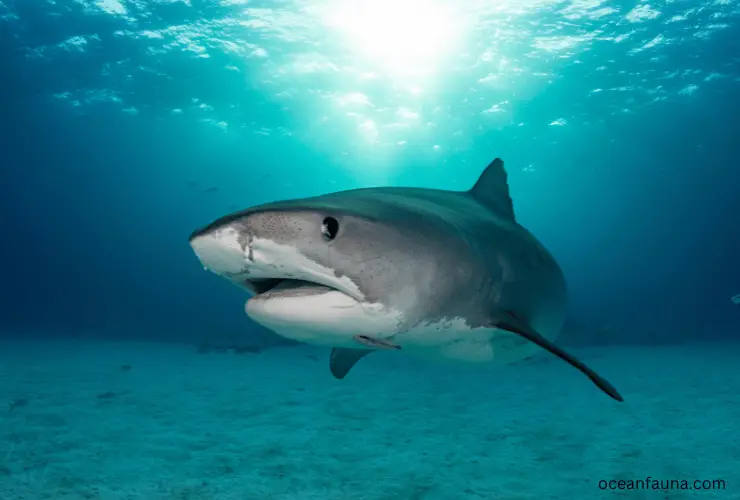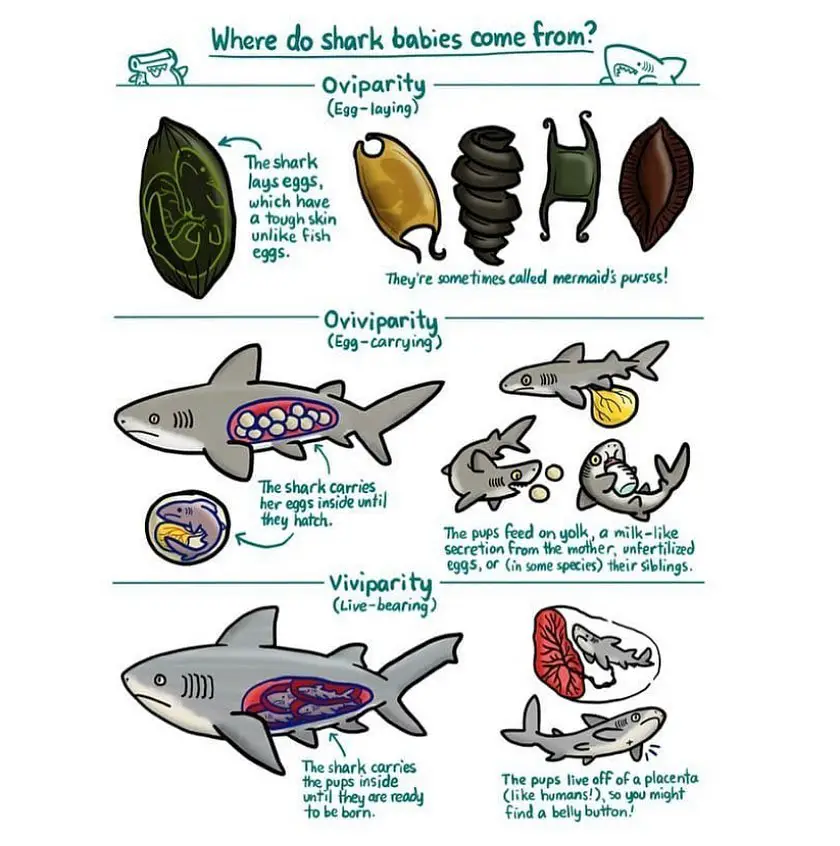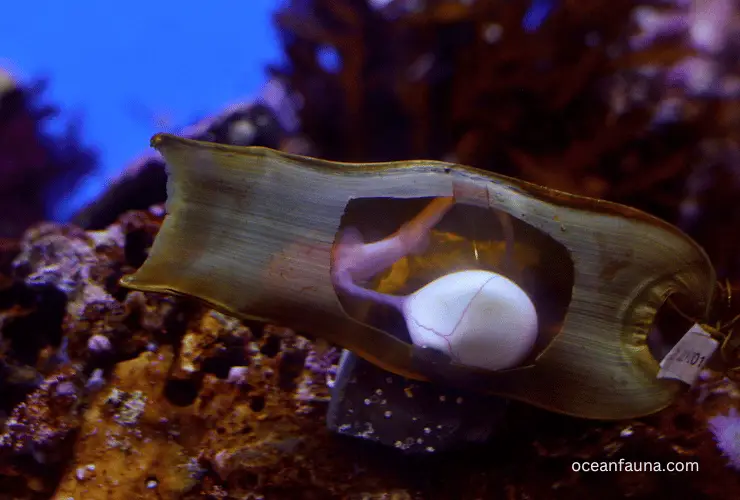Have you ever pondered sharks lay eggs? The answer is yes; some shark species are known as oviparous, meaning they reproduce by laying eggs. But most sharks give birth to live offspring, making them viviparous.
There’s much more to learn about these fascinating creatures! So, read on.
Why Do All Sharks Not Lay Eggs?
Sharks are diverse creatures with a wide range of reproductive strategies. While some sharks lay eggs and leave them to develop independently, most give birth to live young that they have incubated until they are ready to hatch.
Oviparous (egg-laying) sharks lay their eggs in an ocean where they are exposed to water currents, which allow the eggs to be oxygenated and have access to food sources. The egg cases are made up of a tough protein material that protects the embryo as it develops. These egg cases can be attached to rocks, driftwood, or vegetation on the seafloor or float at the ocean’s surface.

Most sharks, however, reproduce through ovoviviparity – they do not actually lay eggs but instead retain their fertilized eggs within their bodies, and these embryos develop until they are ready for birth. The mother provides nutrients directly from her body for the embryos’ nourishment and protection until hatching is complete.
In this way, these young sharks receive optimal care from their mothers before entering the ocean. This form of reproduction is seen in many species, including white sharks, sand tiger sharks, and mako sharks.
Finally, one other way that some sharks reproduce is through aplacental viviparity – also known as ‘live bearing’ where there is no use of an egg case at all, and instead, pups develop inside the uterus as mammals do with placental connections between mother and pup – this method is seen in hammerhead and dogfish species among others.
List of Oviparous, Viviparous, and Ovoviviparous Sharks
| Oviparous | Viviparous | Ovoviviparous |
| Horn sharks, Carpet sharks, Catsharks, Bamboo sharks, Bullhead, Swell sharks, Zebra sharks etc. | Sharpnose sharks, Lemon sharks, Spiny Dogfish, Mako sharks, Hammerheads, Porbeagle sharks, Bull sharks, Blue sharks, etc. | Angel sharks, Atlantic Nurse sharks, Thresher sharks, Wobbegong sharks, Sand sharks, Frilled sharks, etc. |
Oviparous sharks are a group of fish that lay eggs (oviparous) instead of giving birth to live young (viviparous). These species are typically found in shallower, warmer waters and tend to have larger litters than their viviparous counterparts.

In contrast, viviparous sharks are a group of fish that give birth to live young instead of laying eggs. Viviparity enables the offspring to receive nourishment from their mother before they enter the aquatic environment. These species often inhabit deeper waters and may have smaller litters than their oviparous counterparts.
Both oviparous and viviparous species have unique reproductive strategies that enable them to survive in different ocean environments. Oviparous species typically release large numbers of eggs into warmer shallow water habitats which increases their chance for survival due to more abundant food sources than deeper ocean depths where viviparous species primarily inhabit.
However, ovoviviparity is another type of reproduction seen in some shark species where embryos initially develop inside eggs within the mother’s body but eventually hatch in the uterus after receiving nutrition from a placenta-like structure formed by either direct contact between the eggshell and uterine lining or specialized cells on the egg’s surface.
What Are the Three Different Ways Sharks Give Birth?
Sharks can come into the world in three different ways – viviparity, oviparity, and ovoviviparity.
When a shark is born through viviparity, the eggs are retained within the mother’s body until they hatch, and the young sharks are released alive.
In oviparous species like whitetip and blue sharks, eggs are laid in an egg case that often wedges itself among rocks or coral. The embryos develop inside the case until they hatch out alive.
Finally, with ovoviviparous species such as great whites and many other requiem sharks, fertilized eggs form inside the mother’s uterus but remain unattached to her body. As they grow larger and more numerous, they eventually consume one another before emerging from their egg cases as they live young.
The development period of most shark embryos lasts anywhere from 3-9 months, depending on species and environmental factors such as temperature and oxygen levels.
Some species of live-bearing sharks even have fascinating evolutionary adaptations that allow them to survive gestation without being eaten by their developing siblings!
How Do Oviparous Sharks Lay Eggs?
Oviparous sharks lay their eggs in protective cases or capsules known as ‘mermaid purses.’ These egg cases, which may be referred to as ootheca, are usually attached to reefs, rocks, and other structures with a sticky material produced by the mother.
The egg cases have leathery or rigid shells that offer protection from various environmental conditions such as water temperature, predators, and tide levels. These egg cases are kept safe from predation by being attached to the substrate.

Fertilization inside the egg case occurs when sperm enters through small openings in its tough surface and is released into the egg capsule. The eggs are then left unattended by the parents after they are laid, relying solely on their protective shell for defence and nourishment until they hatch several weeks to months later.
Depending on factors such as water temperature and oxygen concentrations within the egg capsule, hatching can occur in different timescales ranging from days to years.
Once hatched, these young sharks enter a larval stage where they undergo further development before continuing with their life cycle. They will remain in this larval stage for an extended period until they mature enough to fend for themselves and continue living independently in open waters.
How Do Viviparous Sharks Give Birth?
Viviparous sharks give birth to their young in a few different ways. The most common way is for the mother shark to carry the eggs internally within her body until they are ready to be born.
As a result, these unborn pups receive nutrients from their mother through a placenta-like structure called the yolk sac placenta. This yolk sac allows the mother to pass oxygen, nutrients, and other substances to the developing embryo.
In some species of viviparous sharks, such as lemon sharks, the female does not possess an egg-laying apparatus, so she gives birth directly to live young. Once born, these pups can measure anywhere from 4 to 12 inches long and weigh up to 1 pound.
They are self-sufficient and able to swim immediately after birth. Generally speaking, viviparous sharks will have litters of four and twenty pups at a time.
Compared with oviparous (egg-laying) species of sharks, viviparous species tend to require more energy than their egg-laying counterparts to reproduce successfully – this is because they do not lay hardy eggs that can withstand prolonged exposure outside of their bodies.
Additionally, it is believed that the pups of viviparous species of sharks may benefit from internal development as it allows them extra time for growth before being exposed to potential predators in the open ocean environment.
How Are Ovoviviparous Sharks Born?
Ovoviviparous (“egg live birth”) sharks are born in a unique way. Unlike other shark species that lay eggs outside the body and abandon them, ovoviviparous sharks keep the egg inside their bodies until the baby is ready to emerge. The egg of an ovoviviparous shark is often surrounded by a thin membrane instead of a hard shell.
In some cases, more than one egg may be enclosed within the same membrane; this group of eggs is known as a candle.
The mother shark will retain the eggs until they are ready to hatch by absorbing oxygen through her uterus walls. The embryo soon sheds the membrane and continues developing in its mother’s uterus until it is ready to be born.
At this point, the embryonic shark will break out of its egg membrane and swim freely without assistance from its mother. This type of birth also allows for larger litters due to more space available in the womb, which increases survival rates among newborn sharks.
Unlike other types of sharks which are commonly born alone, ovoviviparous species usually have several siblings at birth and must compete for resources immediately after hatching. This competition helps strengthen their skill sets early on so they can survive in their respective environments.
Additionally, suppose conditions become unfavorable during development, such as low oxygen levels or lack of food. In that case, embryos can be cannibalized by their own mothers or aborted – both decisions being based on survival instinct for the rest of her litter.
What Are the Differences Between Ovoviviparous And Viviparous Sharks?
Viviparous sharks differ from ovoviviparous in several ways, the most significant being their reproduction method.
Viviparous sharks undergo internal fertilization, where the egg develops inside the mother until it is born as a live young shark, while the ovoviviparous possess eggs that grow and are hatched within the mother, but unlike their counterparts, they lack a placenta system to deliver nutrients to their offspring.
Furthermore, when comparing these two types of Sharks, there is also a difference in temperature levels; viviparous sharks reproduce in warmer water temperatures than those ovoviviparous sharks.
How Long Are Sharks Pregnant?
Sharks have a gestation period of approximately 12 months, varying the length of time among species. Generally, sharks can take anywhere from nine to 18 months to fully gestate their young before they are ready to be born.
During this time, a female shark will typically experience two separate periods of egg yolk absorption followed by a period in which the eggs become enveloped in a membranous capsule and are then released into the open ocean. Many species of sharks give birth to live young, but some lay eggs that hatch later on.
How Big Are Shark Eggs?
The size of shark egg cases can vary greatly depending on the species. For instance, the small-spotted catshark or lesser spotted dogfish (Scyliorhinus Canicula) lay eggs that are approximately 5 cm (2 inches) long, while those of the greater spotted dogfish (S. Stellaris) measure about 10 cm (4 inches).

Generally speaking, these egg cases are more commonly known as ‘mermaid’s purses’ due to their unique shape and texture. They have four corners and are typically covered in tough leathery skin with spines and tendrils protruding from them. In some cases, they can even be light brown or dark brown.
Most shark eggs will also contain a large yolk sac which contains vital nutrients that help protect the growing embryo as it develops. This is generally surrounded by several additional layers of jelly, which provide extra protection against predators and other environmental hazards.
The size and shape of these jelly layers can vary significantly depending on the species of shark involved. As such, they may range from small spherical forms to larger elongated shapes with multiple indentations that create an intricate pattern on their surface.
Conclusion
Hopefully, you get your answer that not all sharks lay eggs. Only the oviparous sharks do, and even within that group, there is variation in the size and shape of eggs.
On the other hand, there are two more types of sharks, namely the ovoviviparous and viviparous. These do not lay eggs; the embryos develop within the mother shark in her uterus.


4 thoughts on “Do Sharks Lay Eggs? [Incredible Facts]”